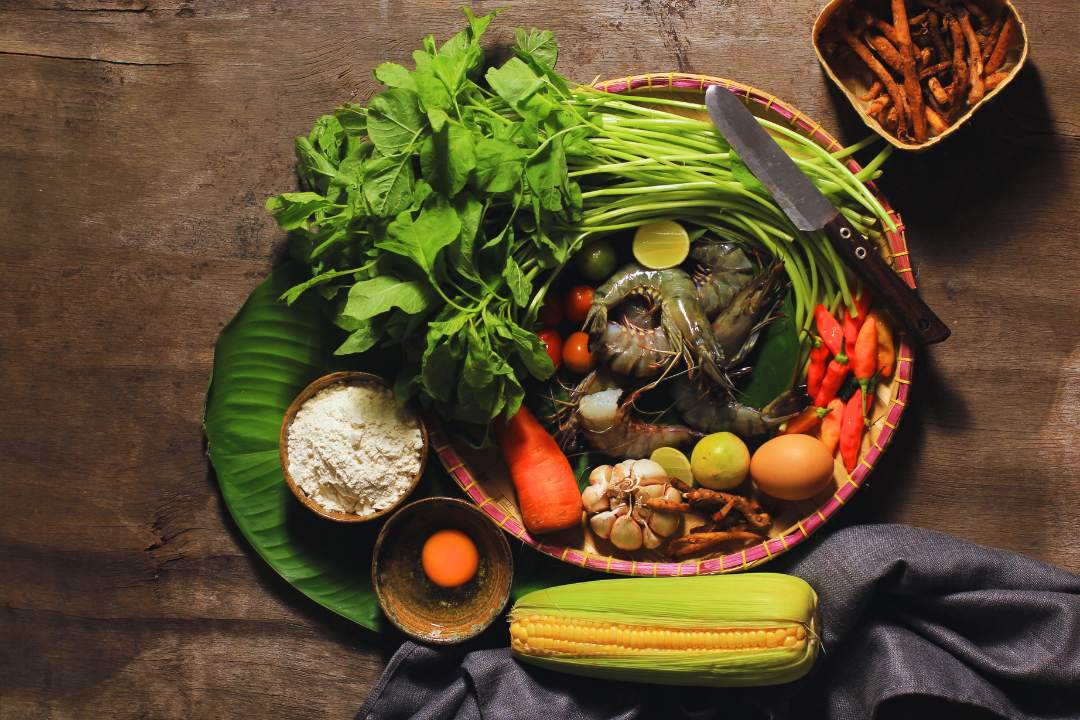15 Must-Try Khmer Recipes That Will Make Your Taste Buds Dance
Get ready to discover 15 must-try Khmer recipes that will have you craving more! From aromatic curries to zesty salads, Cambodian cuisine is a treasure trove of flavors waiting to be explored.
Did you know that Khmer cuisine is one of the oldest living food cultures in the world?
Or that it combines influences from ancient Khmer traditions, neighboring countries, and even French colonial history?
Prepare to be amazed by the rich tapestry of tastes and textures that await you in these authentic Cambodian dishes!

Here’s a quick rundown of the 15 must-try Khmer recipes we’ll be diving into!
Recipe Index
- Fish Amok
- Lok Lak (Stir-fried Beef)
- Nom Banh Chok (Khmer Noodles)
- Samlor Korko (Stirring Pot Soup)
- Beef Saraman Curry
- Char Kroeung Sach Ko (Stir-fried Lemongrass Beef)
- Bai Sach Chrouk (Pork and Rice)
- Kuy Teav (Noodle Soup)
- Prahok Ktis (Pork and Coconut Dip)
- Num Ansom Chek (Banana Sticky Rice Cake)
- Lap Khmer (Lime-marinated Khmer Beef Salad)
- Char Kdav (Caramelized Palm Sugar Chicken)
- Maam Snoul (Fermented Fish)
- Nom Kong (Khmer Donuts)
- Twa Ko (Khmer Sausage)
Now, let’s look deeper into each of these mouthwatering Khmer dishes!
1) Fish Amok: The Crown Jewel of Khmer Cuisine
Fish Amok is often hailed as the national dish of Cambodia, and for good reason! This velvety curry is a perfect blend of fresh river fish, aromatic kroeung (a Khmer spice paste), and creamy coconut milk. The mixture is traditionally steamed in banana leaf cups, resulting in a delicate, mousse-like texture that’ll make your taste buds dance.
To make Fish Amok at home:
- Start with fresh, firm white fish like snakehead or catfish
- Prepare the kroeung paste with lemongrass, kaffir lime, galangal, and turmeric
- Mix the fish with kroeung, coconut milk, and egg
- Steam the mixture in banana leaf cups or ramekins
- Garnish with sliced kaffir lime leaves and red chili
Fun fact: The name “amok” refers to the process of steam cooking in banana leaves, a technique that’s been used in Cambodia for centuries!
Editor’s Note: This article was last updated on August 22, 2024, by our team of local Cambodian food experts. We regularly review and update our content to ensure you have the most up-to-date and accurate information about Khmer cuisine.
2) Lok Lak: A Fusion of Flavors
Lok Lak is a prime example of how Khmer cuisine has evolved over time, incorporating influences from neighboring countries. This dish features tender cubes of beef (or sometimes chicken) stir-fried in a savory sauce, served with a side of rice, fresh veggies, and a tangy lime-pepper dipping sauce called tuk merec.
Key components of a great Lok Lak:
- High-quality beef, cut into bite-sized cubes
- A marinade featuring oyster sauce, soy sauce, and a touch of sugar
- Quick stir-frying to keep the meat tender
- Fresh lettuce, tomatoes, and cucumber on the side
- The all-important tuk merec dipping sauce
Did you know? Lok Lak is thought to have Vietnamese origins, but it’s been embraced and adapted by Cambodians to suit local tastes.
3) Nom Banh Chok: The Breakfast of Champions
Also known as Khmer noodles, Nom Banh Chok is a beloved breakfast dish that’s often sold by street vendors in the early morning hours. It consists of rice noodles served with a fragrant fish-based green curry sauce and a variety of fresh vegetables and herbs.
To enjoy Nom Banh Chok like a local:
- Start with a base of soft, slightly fermented rice noodles
- Ladle on the green curry sauce made with fish, lemongrass, and kaffir lime leaves
- Add a generous helping of fresh bean sprouts, banana flower, and cucumber
- Sprinkle with chopped mint, basil, and water lily stems
- Mix it all together and savor the explosion of flavors!
If you’re planning a trip to Siem Reap, why not combine your culinary adventures with some sightseeing? Check out the Siem Reap Private City Tour to explore the city’s hidden gems and local food spots!
4) Samlor Korko: A Taste of Cambodian Home Cooking
Samlor Korko, often called the “stirring pot soup,” is a hearty dish that showcases the variety of vegetables used in Khmer cuisine. This nutritious soup typically includes pumpkin, green papaya, various gourds, and either pork or fish. The key to its unique flavor is the use of prahok, a fermented fish paste that adds depth and umami to the broth.
Ingredients you might find in Samlor Korko:
- Pumpkin or winter squash
- Green papaya
- Long beans
- Eggplant
- Moringa leaves
- Prahok (fermented fish paste)
- Kroeung spice paste
- Pork or fish
Pro tip: Don’t be put off by the strong smell of prahok – it mellows out during cooking and adds an incredible depth of flavor to the soup!
5) Beef Saraman Curry: A Taste of Cambodia’s Muslim Influence
Beef Saraman Curry is a rich, slow-cooked dish that reflects the influence of Cham Muslim culture on Khmer cuisine. Similar to a Malay or Thai Massaman curry, this dish is packed with warm spices like cardamom, cinnamon, and star anise, creating a complex and aromatic flavor profile.
Key elements of Beef Saraman Curry:
- Tender chunks of beef, slow-cooked until melt-in-your-mouth soft
- A paste made with roasted peanuts, giving the curry its signature richness
- Warm spices like cardamom, cinnamon, and star anise
- Coconut milk for a creamy, luxurious texture
- A hint of tamarind for a subtle tanginess
Fun fact: The word “Saraman” is thought to be derived from “Sulaiman,” a common name among Cham Muslims in Cambodia.
6) Char Kroeung Sach Ko: The Art of Stir-Frying
Char Kroeung Sach Ko, or stir-fried lemongrass beef, is a dish that perfectly showcases the aromatic herbs and spices used in Khmer cooking. The star of this dish is kroeung, a fragrant paste made with lemongrass, galangal, kaffir lime leaves, and other aromatics.
How to make Char Kroeung Sach Ko:
- Prepare the kroeung paste by pounding lemongrass, galangal, kaffir lime leaves, turmeric, and garlic
- Slice beef thinly and marinate it in oyster sauce and soy sauce
- Stir-fry the beef with the kroeung paste until fragrant
- Add sliced onions and red bell peppers for color and crunch
- Finish with a sprinkle of holy basil leaves
Serve this aromatic stir-fry with steamed rice for a quick and delicious meal that captures the essence of Khmer cuisine.
7) Bai Sach Chrouk: Simple Yet Satisfying
Bai Sach Chrouk, or pork and rice, is a popular breakfast dish that proves sometimes the simplest foods are the most satisfying. This dish features thinly sliced pork marinated in garlic and palm sugar, then grilled to perfection and served over broken rice.
The key components of Bai Sach Chrouk:
- Thinly sliced pork belly or shoulder
- A marinade of garlic, palm sugar, and fish sauce
- Broken rice (fractured rice grains with a softer texture)
- Pickled vegetables (usually carrots and daikon radish)
- A side of clear broth soup
Pro tip: For the most authentic experience, try to find palm sugar for the marinade – it adds a unique caramel-like sweetness that’s quintessentially Cambodian.
8) Kuy Teav: The Ultimate Comfort Food
Kuy Teav is a comforting rice noodle soup that’s often enjoyed for breakfast but can be found throughout the day at street-side stalls and restaurants. While there are many variations, the most common version features a savory pork broth, rice noodles, and various toppings.
Essential elements of a good Kuy Teav:
- A clear, flavorful broth made by simmering pork bones and dried squid
- Thin rice noodles cooked to a perfect al dente
- Toppings like sliced pork, shrimp, and offal (for the adventurous eater)
- Fresh bean sprouts, chopped scallions, and fried garlic
- Condiments like lime wedges, chili sauce, and fish sauce on the side
Did you know? Kuy Teav is believed to have Chinese origins, but it’s been adapted and embraced as a Khmer dish over the centuries.
9) Prahok Ktis: A Bold and Flavorful Dip
Prahok Ktis is a savory dip that showcases the bold flavors of Cambodian cuisine. Made with fermented fish paste (prahok), minced pork, and coconut milk, this dip is typically served with fresh vegetables and rice.
How to enjoy Prahok Ktis:
- Prepare the dip by cooking minced pork with prahok, kroeung paste, and coconut milk
- Serve warm with a variety of fresh vegetables like cucumber, long beans, and cabbage
- Use sticky rice or regular steamed rice to scoop up the dip
- Embrace the strong flavors – it might be an acquired taste, but it’s truly addictive!
Fun fact: Prahok is often called “Cambodian cheese” due to its strong smell and flavor profile. It’s an essential ingredient in many Khmer dishes.
10) Num Ansom Chek: A Sweet Treat
Num Ansom Chek, or banana sticky rice cakes, are a popular dessert often prepared for special occasions and festivals. These sweet treats are made by wrapping a mixture of sticky rice, banana, and coconut milk in banana leaves before steaming.
Steps to make Num Ansom Chek:
- Soak sticky rice overnight, then mix with coconut milk and a pinch of salt
- Prepare ripe bananas by mashing them with palm sugar
- Wrap the rice and banana mixture in banana leaves, forming small parcels
- Steam the parcels for about an hour until the rice is fully cooked
- Serve warm or at room temperature as a snack or dessert
These sweet, fragrant parcels are not only delicious but also make for a beautiful presentation when unwrapped.
11) Lap Khmer: A Zesty Salad with a Kick
Lap Khmer, also known as lime-marinated Khmer beef salad, is a refreshing dish that’s perfect for hot Cambodian days. This salad features thinly sliced beef that’s “cooked” by marinating in lime juice, similar to a ceviche.
Key ingredients in Lap Khmer:
- Thinly sliced beef (sometimes quickly seared)
- Lime juice for marinating
- Fish sauce for seasoning
- Chopped fresh herbs like mint, basil, and sawtooth coriander
- Thinly sliced shallots and garlic
- Bird’s eye chilies for heat
Pro tip: If you’re not comfortable with raw beef, you can briefly sear the meat before marinating. It’ll still be delicious!
12) Char Kdav: Sweet and Savory Perfection
Char Kdav, or caramelized palm sugar chicken, is a dish that perfectly balances sweet and savory flavors. The chicken is slowly cooked in a sauce made with palm sugar, fish sauce, and garlic, resulting in a sticky, caramelized glaze.
How to make Char Kdav:
- Start by caramelizing palm sugar in a wok or large skillet
- Add chicken pieces and stir to coat with the caramel
- Add fish sauce, garlic, and a touch of water
- Simmer until the chicken is cooked through and the sauce has thickened
- Finish with a sprinkle of black pepper and serve with steamed rice
The key to this dish is achieving the perfect caramel color without burning the sugar – it takes practice, but the results are worth it!
13) Maam Snoul: For the Adventurous Eater
Maam Snoul is a fermented fish dish that’s not for the faint of heart but is beloved by many Cambodians. This pungent delicacy is made by fermenting fish with salt and rice, resulting in a strong, umami-rich flavor.
How Maam Snoul is typically enjoyed:
- The fermented fish is often grilled or fried before serving
- It’s commonly eaten with rice and fresh vegetables
- Sometimes it’s used as a flavoring agent in soups or dips
- True enthusiasts enjoy it with beer or rice wine
While Maam Snoul might be an acquired taste for some, it’s a great way to experience the depth and complexity of Khmer cuisine.
14) Nom Kong: A Sweet Street Food Favorite
Nom Kong, or Khmer donuts, are a popular street food snack that satisfies sweet cravings. Unlike Western-style donuts, Nom Kong are made with rice flour and palm sugar, giving them a unique texture and flavor.
How Nom Kong are made:
- Rice flour is mixed with palm sugar, coconut milk,
and a touch of salt to form a dough 2. The dough is shaped into small rings 3. These rings are deep-fried until golden and crispy 4. Often, they’re served with a sprinkle of sesame seeds for extra flavor and crunch
Nom Kong are perfect for a quick snack or as a sweet ending to a meal. They’re often sold by street vendors, filling the air with their irresistible aroma.
15) Twa Ko: Cambodian Sausage Delight
Last but not least, we have Twa Ko, a flavorful Khmer sausage that’s packed with herbs and spices. These sausages are a testament to the Cambodian love for bold, aromatic flavors.
What makes Twa Ko special:
- A mixture of minced pork and beef
- Fragrant kroeung paste for that signature Khmer flavor
- Prahok for an extra umami kick
- Sometimes filled with whole peppercorns for a spicy surprise
- Often grilled or fried before serving
Twa Ko can be enjoyed on its own as a snack or served with rice as part of a larger meal. It’s a great introduction to the complex flavors of Khmer cuisine.
Bringing Khmer Flavors to Your Kitchen
Now that we’ve explored these 15 must-try Khmer recipes, you might be eager to try them in your own kitchen. Here are some tips to help you get started:
- Stock up on essential ingredients: Items like fish sauce, palm sugar, and lemongrass are crucial for authentic Khmer flavors. You can find these at Asian grocery stores or online.
- Make your own kroeung: This aromatic paste is the backbone of many Khmer dishes. While you can buy pre-made versions, nothing beats the freshness of homemade kroeung.
- Don’t fear fermentation: Ingredients like prahok might seem intimidating, but they add incredible depth to dishes. Start with small amounts and adjust to your taste.
- Embrace fresh herbs: Cambodian cuisine relies heavily on fresh herbs. Don’t skimp on these – they’re essential for authentic flavor.
- Balance your flavors: Khmer cuisine is all about balancing sweet, sour, salty, and umami flavors. Don’t be afraid to adjust seasonings to suit your palate.
If you’re planning a trip to Cambodia to taste these dishes firsthand, consider taking a Siem Reap 5 Day Tour. It’s a great way to explore the local cuisine alongside the stunning temples and cultural sites.
From the Expert’s Kitchen
We spoke with Chef Sopheak, a renowned Cambodian chef, who shared his thoughts on Khmer cuisine:
“Khmer food is all about fresh ingredients and bold flavors. We use a lot of herbs and spices, but always in balance. It’s not about overpowering heat like some might expect. Instead, it’s about creating layers of flavor that come together harmoniously.”
Chef Sopheak’s top tip for home cooks trying Khmer recipes: “Don’t rush. Many of our dishes require slow cooking or marinating. This allows the flavors to develop fully. And always taste as you go – that’s the key to mastering Khmer cuisine.”
Wrapping Up Our Culinary Journey
There you have it – 15 must-try Khmer recipes that showcase the diversity and deliciousness of Cambodian cuisine. From the creamy richness of Fish Amok to the bold flavors of Prahok Ktis, these dishes offer a tantalizing glimpse into the culinary treasures of Cambodia.
Whether you’re planning a trip to Cambodia or just want to expand your culinary horizons at home, these recipes are a great place to start. Remember, cooking is an adventure, so don’t be afraid to experiment and make these dishes your own.
For those who want to experience these flavors firsthand, why not consider a 7 Days in Siem Reap and Battambang Tour Itinerary? It’s a fantastic way to immerse yourself in Cambodian culture and cuisine.
So, what are you waiting for? Grab your wok, stock up on some fish sauce, and get ready to make your taste buds dance with these amazing Khmer recipes!
Featured
Explore more on My Siem Reap Tours
Koh Ker and Beng Mealea guided tour | Banteay Srei temple tour semi-private guided tour | Angkor Wat Sunrise shared tour | Koh Ker and Beng Mealea guided tour | Morning Siem Reap floating village tour | Afternoon Siem Reap floating village tour | Private Angkor Wat special tour | Kulen Waterfall small group guided Tour | Private Angkor Wat mix temples photo tour















